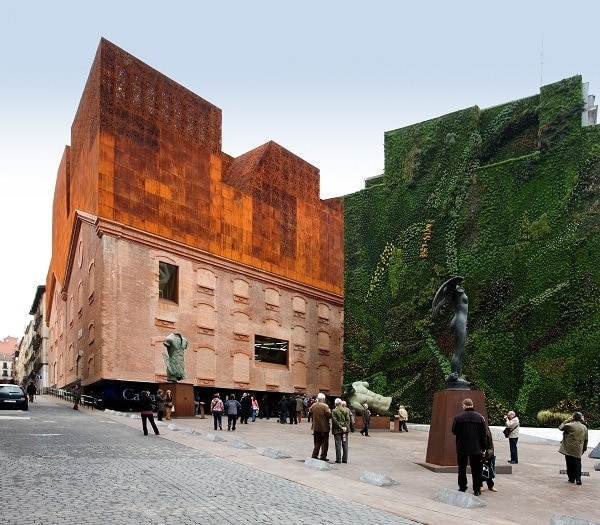
Heathrow Airport has recently unveiled a wall of plants which aims to give passengers a sense of calm before their journey and make their journey better. Passengers with flights departing from Gate 25 in Terminal 3 can now inhale fresh air and enjoy some natural rest and relaxation as they wait to board their flight. The plants have been carefully chosen and include the Peace Lily and English Ivy, plants that are used to keep the air fresh on the International Space Station owing to their distinct natural properties. The “Garden Gate” which was set up by green building specialist Biotecture is made up of seven irrigated panels and has a total of 1681 plants. If all goes to plan, the green wall could spread to other areas of the airport in the near future. Transportation hubs like Heathrow are an ideal spot for green infrastructure to become an investment in public health and wellbeing.
This is not the first time that a Ferrovial project has introduced a green wall. Museum and cultural centre Caixa Forum Madrid is home to a vertical garden that was installed back in 2008, making it the first of its kind in Spain.The garden which measures 460 square metres (4 storeys high) has a phenomenal 15,000 plants representing 250 different species. It was created by botanist Patrick Blanc, the inventor of the vertical garden, who is responsible for some of the most famous vertical gardens in Europe. Today the green wall is cared for by our very own Ferrovial Services, ensuring that the plants get all the water and nutrients that they need.
So what are the benefits of vertical gardens? And why are so many companies investing in this type of green architecture? Vertical gardens have many important aesthetic, economic, physiological and environmental benefits. Here are some of them…
Find out the benefits of vertical gardens
Vertical Gardens – The aesthetic benefits
As Australian painter Sir William Dobell said:
“A sincere artist is not one who makes a faithful attempt to put on to canvas what is in front of him, but one who tries to create something which is, in itself, a living thing.”
- Vertical gardens are a great way to both maximise limited space and reclaim disregarded space by transforming empty space into something aesthetically pleasing and creatively stimulating. They can be seen as a natural tapestry on a building.
Environmental benefits
Vertical gardens…
- Reduce the urban heat island effect and smog. Urban heat island (UHI) refers to a city or metropolitan area that is significantly warmer than the surrounding rural areas because of human activities.
- Clean the outside air of pollutants and dust and also help to offset the carbon footprint of both people and fuel emissions.
- Plants also improve indoor air quality as they remove harmful VOCs (volatile organic compounds) and other harmful toxins like benzene and formaldehyde.
- Act as a natural sound proofing barrier. The vegetated surface blocks high frequency sounds, and when built with a substrate or growing medium support they can also block out low-frequency noises.
- Increase biodiversity by creating habitats for birds and insects. Green walls can help to mitigate the loss of biodiversity caused by urbanization and help to sustain a variety of plants and insects.
- Can be used to grow food such as small fruit, vegetables and herbs in urban settings, creating sustainable and local control of food sources.
Physiological benefits
Plants reduce stress
- Professor Virginia Lohr of Washington State University found in a study, that plants reduce the physical signs of stress. Dr. Lohr discovered that people working in an environment with plants present were 12% more productive and less stressed than those who worked in an environment without plants.There are numerous other studies that highlight the positive impact of green spaces upon human well being. Honeyman 1987 found that buildings that feature and promote access to vegetation have a greater positive human health impact than those without. Green buildings have even been shown to increase post-operative recovery rates in medical facilities (Ulrich 1983).
Economic benefits
Vertical gardens…
- Increase foot traffic in retail spaces as green walls create spaces that people want to spend time in.
- Provide thermal insulation.
As green walls provide insulation to buildings there is less demand upon power, saving cash as well as reducing the amount of nasty polluting by-products that are released into the atmosphere.
- Vertical gardens both insulate and cool buildings, providing a kind of safety blanket that protects the building from the elements, saving money on repairs in the long run.
- Create local jobs. Vertical gardens require the expertise of professionals from a variety of disciplines including landscape architects, architects, irrigation consultants and more.
Want to find out how to make your own vertical garden at home? Read this post on Ferrovial Blog.
You can learn more about other types of Green Buildings in this post from Marcos Martinez.









1 comment
Vista Concepts
14 of March of 2023
Ever felt like making your unused space more attractive? The most significant benefits and advantages of artificial wall gardens are quite versatile, which helps your work environment be relaxed and peaceful. Smart water management that is scientific and well-designed ensures good control over irrigation and construction. You can get more amazing and trending designs for commercial spaces. Reach us. More information is available at https://www.vistaconcepts.com.au/.